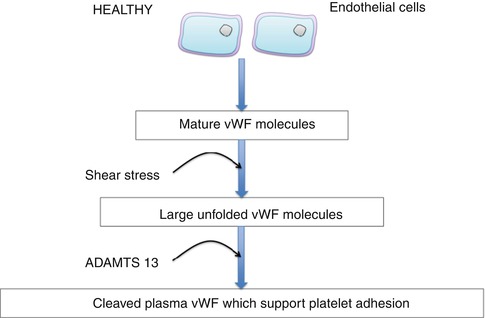and Christopher Isles2
(1)
Institute of Cardiovascular and Medical Sciences, University of Glasgow, Glasgow, UK
(2)
Dumfries and Galloway Royal Infirmary, Dumfries, UK
Q1 What does the abbreviation HUS/TTP stand for?
It stands for Haemolytic Uraemic Syndrome/Thrombotic Thrombocytopenic Purpura, two clinical syndromes each characterized by Microangiopathic Haemolytic Anaemia (MAHA) and thrombocytopenia. The term thrombotic microangiopathy is used to describe patients with these disorders. Although there are subtle differences between HUS and TTP (see Q7), it is helpful to consider them as different manifestations of the same disease process
Q2 What is meant by the term Microangiopathic Haemolytic Anaemia?
MAHA is a sine qua non of HUS/TTP. It is a form of intravascular haemolysis with prominent red cell fragmentation (schistocytes) on the blood film. Red cells fragment when they are caught on fibrin strands in the microcirculation (Fig. 14.1).


Fig. 14.1
Schistocyte (arrowed) as seen on a blood film
Q3 What other features of haemolysis will be present in these patients?
The haemolysis of MAHA is typically associated with evidence of intravascular red cell destruction (raised indirect bilirubin, reduced serum haptoglobin) and compensatory increased red cell production (raised reticulocyte count). Serum LDH is usually extremely high reflecting both haemolysis and tissue damage due to systemic ischaemia. Because the haemolysis is non-immune the direct Coomb’s test (direct antibody test) will be negative.
Q4 What is the commonest cause of HUS/TTP in adults?
Most cases are in adults are due to ADAMTS13 deficiency which may be congenital or required. ADAMTS13 is a specific von Willebrand factor (vWF) cleaving enzyme. Congenital cases are usually due to inherited deficiency while acquired cases are more likely a consequence of an auto-antibody to this enzyme.
Q5 How does ADAMTS13 deficiency cause HUS/TTP?
Healthy endothelial cells produce vWF – a protein that is unfolded by shear stresses in the circulation then cleaved by a metalloproteinase enzyme called ADAMTS13 in order to support platelet adhesion (Fig. 14.2).


Fig. 14.2
Normal mechanism of ADAMTS13 cleaving vWF molecules to support normal platelet adhesion
Absence or reduced activity of the vWF cleaving enzyme leads to a build-up of unusually large vWF molecules which in turn cause platelet aggregation in the microcirculation, so called Thrombotic Microangiopathy (TMA) (Fig. 14.3)
 < div class='tao-gold-member'>
< div class='tao-gold-member'>





Only gold members can continue reading. Log In or Register to continue
Stay updated, free articles. Join our Telegram channel

Full access? Get Clinical Tree








